|
 
IN
THE NEWS | CALENDAR
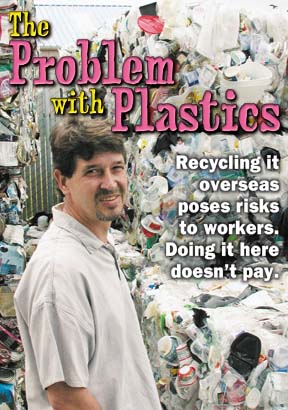
by EMILY
GURNON
RECYCLING. IT'S GOOD FOR THE
ENVIRONMENT.
It stems the flow of garbage
to our landfills. It makes old things new. We can even collect
money for our recycling efforts.
Let's face it, recycling makes
us feel good. We don't have to toss that plastic Pepsi bottle
in the trash, knowing it will lie dormant in a landfill for eons.
And here in environmentally conscious Humboldt County, recycling
is The Thing to Do.
So when the recycling centers
in Arcata and Eureka recently began taking more of the numbered
plastics -- containers labeled 3 through 7, rather than just
the 1s and 2s -- it was welcomed as good news. As one state official
said, "Recycling is one of those things where more is always
better." But is it?
The recycling of plastic has
a dark side -- one little known to most consumers. The majority
of the plastics we recycle, regardless of type, end up in China,
where worker safety standards are virtually nonexistent and materials
are processed under dirty, primitive conditions. And the economics
surrounding plastic recycling -- unlike those for glass and aluminum
-- make it a dubious venture for U.S. companies.
Breathing fumes
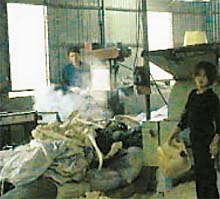 I've
been in the [Chinese] factories and I can smell it," said
Jim Puckett, coordinator of the Seattle-based Basel Action Network,
a nonprofit group working to support the international agreement
on hazardous wastes called the Basel Convention. "It can
give you a headache almost instantly, and [the workers] are hovering
over this melting stuff all day." I've
been in the [Chinese] factories and I can smell it," said
Jim Puckett, coordinator of the Seattle-based Basel Action Network,
a nonprofit group working to support the international agreement
on hazardous wastes called the Basel Convention. "It can
give you a headache almost instantly, and [the workers] are hovering
over this melting stuff all day."
Puckett visited China in December
2001 when his organization was investigating the export of electronics
waste from the United States. While he was there, he also saw
recycling facilities that handled consumer plastics like soda
bottles and plastic bags.
"The ones we witnessed
were pretty bad," Puckett said. Since plastics are made
from petroleum, and since they must be melted down to be recycled,
"the concern is what the emissions exposure will be like,"
he said. The workers, who make about $1.50 a day, "are breathing
it indoors all day long." And some plastics additives, like
flame-retardants, can be toxic when heated, he said. No workers
he saw were wearing masks or other protective equipment. He also
observed labor practices that one would never see in the United
States -- such as small children going through bags of shredded
plastic for hours, sorting the tiny pieces by color.
[photo above right:
Plastic chipper (foreground) and melter unit (behind) in Chinese
recycling factory. Photo © Basel Action Network]
Even worse than the occupational
exposure may be the effect of plastics recycling on the environment
in China, Puckett said. "If stuff has a little bit of contamination
[such as an unidentifiable white dust], workers just dump
it in the countryside. We saw plastic bags floating around
in the fields."
Because plastics are not classified
as hazardous wastes, they are not regulated by international
law. But "from an environmental standpoint, they worry us
a lot," Puckett said.
Puckett readily admitted that
there has been little research on the potential health hazards
in the Chinese facilities or environmental dangers. There is
no information on the long-term health risks workers may be facing,
the number of workers involved, or the number of factories.
California, while pushing heavily
for the recycling of plastics, has not closely examined the conditions
under which the recycling takes place overseas.
"Right now, a lot of our
material is indeed baled and shipped off-shore," said Calvin
Young, market development specialist with the state Integrated
Waste Management Board. "We all hear the horror stories,
but there's not a lot of verified information" about working
conditions in China or elsewhere, he said. A spokeswoman for
the waste board, which manages California's solid waste stream,
said the state's hands are tied. "Once you release the material
and another person buys it, you can't tell them what to do with
it," said Roni Java.
Low conversion
rate
What is clear is that plastic
recycling presents myriad problems. In addition to safety and
environmental questions, technological and economic hurdles have
complicated plastics recycling efforts in the United States.
The result: Plastic containers get turned into new products at
a much lower rate than glass bottles or aluminum cans. The can
you recycle today, for instance, will make its way back to the
supermarket shelf in just six weeks. Because of health concerns,
a plastic bottle will never become another plastic bottle. Recyclers
often have a hard time making ends meet because the demand from
manufacturers for recycled plastic -- and, consequently, the
money paid for it -- is considerably less than for virgin material.
The plastics industry, of course,
has nothing but good things to say about the role of plastics
in our lives. They are "a responsible choice in a more environmentally
conscious world," according to the American Plastics Council,
the national trade association for the plastics industry and
the group responsible for the upbeat "Plastics Make It Possible"
ad campaign. Examples of how plastics "leave a lighter footprint
on the planet" include the argument that plastic grocery
bags are lighter and create less waste by volume than paper sacks,
the industry said. And the fact that plastics are so lightweight
and durable enables manufacturers to use less energy and generate
less waste in production processes, plastic promoters said.
The plastics industry also likes
to tout the many uses of recycled plastic, even publishing a
recycled products directory that lists everything from bookmarks
to boxer shorts to Dumpsters reportedly made with recycled plastic.
The state of California, meanwhile,
earnestly promotes recycling of plastic containers. The state
Department of Conservation announced last week that it is launching
a new campaign to raise public awareness of the growing mounds
of plastic bottles in our landfills and to promote recycling.
"The sight of a water bottle
in someone's hand has become as common as a cell phone,"
said Darryl Young, the department's director.
A proliferation
of plastic
Clearly, there is a dilemma.
Recycling presents problems, yet not recycling hardly seems
an option. Plastic is the fastest-growing portion of our waste
stream and now makes up the second-largest category by volume,
next to paper, of trash going into our landfills, according to
a draft report prepared for the California Integrated Waste Management
Board called the "Plastics White Paper."
Plastics make up 17.8 percent
by volume of what's thrown into California landfills (and 8.9
percent by weight). While consumers are increasingly snapping
those Evian bottles off the shelves, they toss the empties into
the trash bin more often than the recycling bin. The recycling
rate for plastic bottles is only 16 percent -- miserably low
compared to glass and aluminum -- even though consumers can redeem
their used plastic bottles for the same CRV (California Refund
Value) rate as other containers.
California cities and counties
have an incentive to recycle as much material as possible. A
1989 law requires that municipalities reduce the trash they send
to landfills by 50 percent by the year 2000 or face hefty fines.
(Many, like Arcata and Eureka, have received extensions to meet
the goal.)
Diversion, then, becomes the
magic word. But from the point of view of recyclers, accepting
some types of plastic is more trouble than it's worth. For example,
plastics coded 3 through 7 -- cottage cheese, tofu, salsa
and yogurt containers -- are particularly difficult to recycle
profitably. So why take these additional containers at all, especially
when their volume is low? According to Mark Loughmiller, executive
director of the Arcata Community Recycling Center, which also
manages the Hawthorne Street Recycling Center in Eureka, the
answer is public pressure.
"I fought it. There are
no domestic markets for it. At a point you get tired of being
harangued by people coming in trying to quote unquote `do the
right thing.'" They don't want to throw anything
away, he said, and that's all well and good. But a more appropriate
position might be, "I shouldn't buy it in the first place,"
he suggested.
The plastics trail
The plastics collected at the
Arcata and Hawthorne Street sites are baled and stored for about
a month until they fill a 12-ton truckload, Loughmiller said.
The truck typically contains 5 tons of milk bottles (the number
2s), 7 tons of soda and water bottles (the number 1s), and about
three-quarters of a ton of the so-called "mixed plastics,"
the 3s through 7s, which are baled together.
They then make their way to
Ming's Recycling in Sacramento (which also takes all of the plastics
from Humboldt Sanitation in McKinleyville). Kenny Luong, president
of Ming's, said his center has 40 or 50 suppliers in California
and another 30 to 40 elsewhere in the United States and Canada.
Almost all of the plastics that come into Ming's are sold to
brokers in Hong Kong, who pay to transport it via container ship
from the Port of Oakland to China. The transport is cheap because
China exports far more to the United States than we do to them;
the ships traveling back to China have plenty of room.
The mixed plastics don't make
Luong very much money, he said, which explains why the cities
of Arcata and Eureka get nothing for their mixed plastic bales.
(A ton of milk jugs, by contrast, pays about $200; a ton of soda
bottles, $160.)
"It's enough to cover the
transport to the harbor, that's pretty much it," Luong said
of the mixed plastics. He would prefer not to take those at all.
But a change to state law in 2000 expanded the list of beverages
included in the California Redemption Value program. And if the
bottle has a "CRV" on it -- even if it's a number 3
or 4 plastic -- a certified recycling center must accept it and
pay the refund to the consumer.
"It's really a pain in
the butt," Luong said. "There aren't a whole lot, but
we are required to purchase them by law. It prompted us to find
a market for it."
That market, it turns out, consists
of recyclers in Shanghai and Guangdong province. Luong said he
has never seen the China facilities and knows little about them.
"Once it's loaded on the ship, it's out of my hands."
Recycling in Guangdong
One of his brokers has visited
some of the locations in China where plastics from Humboldt end
up -- places similar to those that the activist from the Basel
Action Network saw. Doug Spitzer is the owner of Monarch
Enterprises of Santa Cruz, which is affiliated with the gargantuan
paper company Boise Cascade. He sells plastics to Chinese recyclers
and ran a plastic film-recycling factory himself outside of Guangdong
in the early 1990s.
"Most of our material goes
through Hong Kong into that closest province [to Hong Kong],
which is Guangdong," Spitzer said. One factory will typically
limit itself to one type of plastic, and one village might have
most of its residents involved in that type of recycling, he
said.
"Within this one town outside
of Guangzhou [in Guangdong province], when I was there, my partners
were telling me there were at least 3,000 plastic film processors
there, and they're right next door to each other. It's a small
village; they all process it." The facilities range from
a mom-and-pop operation that takes one container-load per month
to very large, comparatively modern factories.
One Spitzer saw when he visited
four years ago involved soda bottles: The workers would break
open the bales, women would sort the bottles by color, a "guy
with a machete" cut the tops off, two other men scraped
labels off, then the bottles were ground into pellets and melted
down.
It was not the kind of place
that would be approved by the U.S. Occupational Safety and Health
Administration, Spitzer said.
"OSHA would go nuts. The
place is noisy, it's crowded, it's just amazing. Not that they're
killing people off. They're safe, and all the time we were running
the factory there were no major accidents," he said. "Do
people engage in unsafe practices to try to make a living? Yeah,
all over the world."
He said his current business
provides a valuable service. "What I'm doing is I'm supplying
a raw material that can go to a Third World country."
There are some facilities in
the United States that recycle soda bottles and milk jugs "if
the material is clean enough," said Luong of Ming's Recycling.
But the market for recycled plastic makes it difficult, if not
impossible, for recyclers to make any money. The reasons are
many. Since plastic is made from petroleum, virgin plastic makers
have a large supply of raw material available to them. When manufacturers
can buy virgin plastic pellets or flakes for about the same amount
of money as recycled plastic, there is little incentive to use
recycled.
There are also limits to the
products that can be made from recycled plastic. The U.S. Food
and Drug Administration does not allow food containers to be
made into new food containers because they can't be heated at
temperatures high enough to sterilize them. (The FDA has said
it will allow a layer of recycled plastic sandwiched between
layers of virgin plastic in soda bottles.)
A numbers game
Plastic recyclers must also
face the issue of contamination. Recycling the number 1 (PET)
plastics -- the soda bottles -- could work economically were
it not for the number 3s that enter the mix, said Peter Anderson,
a recycling consultant in Madison, Wis., who has worked with
state and federal agencies, including the U.S. Environmental
Protection Agency and the state of California. Number 3 plastics
are polyvinyl chloride, or PVC for short.
"PVC presents enormous
problems because it looks just like PET physically," Anderson
said. "A single bottle of PVC will contaminate the entire
[10,000-bottle] load" aesthetically, causing the new PET
bottles made with the material to be yellowed or, with more contamination,
to have black streaks, he said. There are X-ray scanning machines
that can detect the PVC intruders, but those are too expensive
for many recyclers.
"You can't make plastics
recycling work with PVC in the mix," Anderson said. So,
he argued, taking the 3 through 7 plastics makes no economic
sense. "Who the hell knows what China's doing with them?
I don't think anyone can make a case without a smirk on their
face that they're recycling 3 through 7s."
He called the idea of recycling
all plastics "a serious mistake."
Some recyclers take the 3 through
7 plastics because, they reason, they'll get more of the "good
stuff" -- the soda bottles and milk bottles -- if they advertise
that they accept a wider range of recyclables. Eel River Disposal
in Fortuna, for example, accepts numbers 1, 2 and 3, which they
send to Smurfit Recycling in Oakland.
Eel River owner Harry Hardin
said he doesn't collect enough of the number 3s to make a separate
bale with it, so he bales it with the number 2s. "I even
put some 4s in there," he said.
Asked about the PVC contamination
problem, Hardin said, "It depends what market you send it
into. Smurfit's -- I'm not quite sure what they do with theirs.
But they will allow some number 3 and 2 together."
Not so, said Don Kurtz, plant
manager for Smurfit in Oakland. "If we identify that there
are 3s in there, we reject the bale," he said. Eel River
was recently told to come and get one of their bales that was
turned away for that very reason. "We really don't want
number 3s. It really doesn't make sense for us to mess with it."
(Unlike Ming's, Smurfit is not legally bound to take any particular
recyclables because the company is classified as a "processor,"
not a recycling facility.)
Another Humboldt County recycler
sells his material to a middleman in a different part of the
state. The man, who did not want to be identified, said he does
not collect enough 3 through 7 numbered plastics to bale them
separately, so he mixes them with the bales for the numbers 1
and 2. "Don't advertise that," he said. "It's
garbage plastic, but a lot of people like to recycle it."
His company then sells it to a broker who sends it overseas.
"If they're putting it
in with the PET [number 1s], I guarantee they're getting thrown
out," said the broker, Patty Moore of the Sonoma-based Moore
Recycling Associates.
Destination landfill
All in all, plastic recycling
appears to fall far short of its promise. Even if recycled under
the best of conditions, a plastic bottle or margarine tub will
probably have only one additional life. Since it can't be made
into another food container, your Snapple bottle will become
a "durable good," such as carpet or fiberfill for a
jacket. Your milk bottle will become a plastic toy or the outer
casing on a cell phone. Those things, in turn, will eventually
be thrown away.
"With plastics recycling,
we're just extending the life of a material. We're not creating
a perpetual loop for that material," like we do with glass
and aluminum recycling, said Loughmiller, the Arcata recycling
director.
"I think people really
need to have a reality check on plastics," said Puckett
of the Basel Action Network. "The mantra has been, `divert
from the landfill.' What we've been saying is, divert to what?
Dump it on the Chinese? Plastics recycling needs to be looked
at with a jaundiced eye," he said. "It's not what it's
touted to be."
![[symbol] means recyclable, right?](cover0605-recyclehed.jpg)
IF YOU'VE EVER LOOKED ON THE
BOTTOM OF YOUR PLASTIC JUICE BOTTLE, detergent bottle or tofu
tub, you've seen the little triangle of arrows with a number
inside. That symbol -- contrary to popular belief -- does not
indicate that a container is recyclable.
Back in 1988, "the trade
groups managed to get into law the resin [type of plastic] identification,"
said Mark Loughmiller, executive director of the Arcata Community
Recycling Center. The numbers indicate which category of plastic
the container is made from.
"The triangled arrows imply
recyclability," Loughmiller said. "The plastic industry
denied it was trying to mislead the public and cause confusion."
But that's what happened, he said. People regularly come to his
center and demand to know why their plastic lawn chair with a
number on the bottom can't be recycled.
And why can't it? Because, even
in one category, such as plastics labeled with a number 2 (high
density polyethylene or HDPE), there are many variations. Milk
jugs and yogurt containers, for example, may both be made with
HDPE, but because the recycling process requires melting of the
old containers, and they melt at different temperatures, they
may be incompatible.
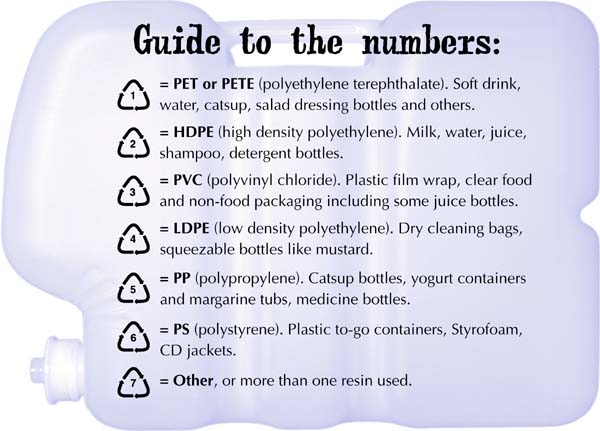
Redway operation
turning milk jugs into planters
Not all of Humboldt County's
plastics travel hundreds or thousands of miles before they are
recycled. Some of them go to R&R Auto Machine in Redway,
where Tom Hoffman and John Schwarz make them into planter boxes
(when Hoffman is not operating heavy equipment and Schwarz is
not repairing motorcycles, that is).
The two entrepreneurs have used
more than 800 pounds of plastic milk bottles to make 10,000 planters
in the year they've been working on the project.
"We don't make any more
money than we would if we just used virgin plastic," Hoffman
said, "but we like to recycle. It's part of the future."
Their operation emits no pollution
and is not dangerous, Hoffman said. "It's a completely self-contained
system."
The planters are available at
the Arcata Community Recycling Center and American Hydroponics
in Arcata."
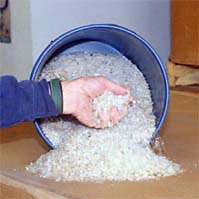 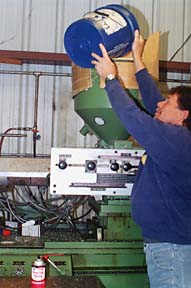 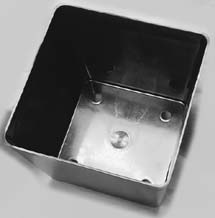
From the left, recycled
plastic from milk jugs after going through the chipper;
Tom Hoffman pours plastic particles into melter and the finished
planter box below.
IN
THE NEWS | CALENDAR
Comments?

© Copyright 2003, North Coast Journal,
Inc.
|